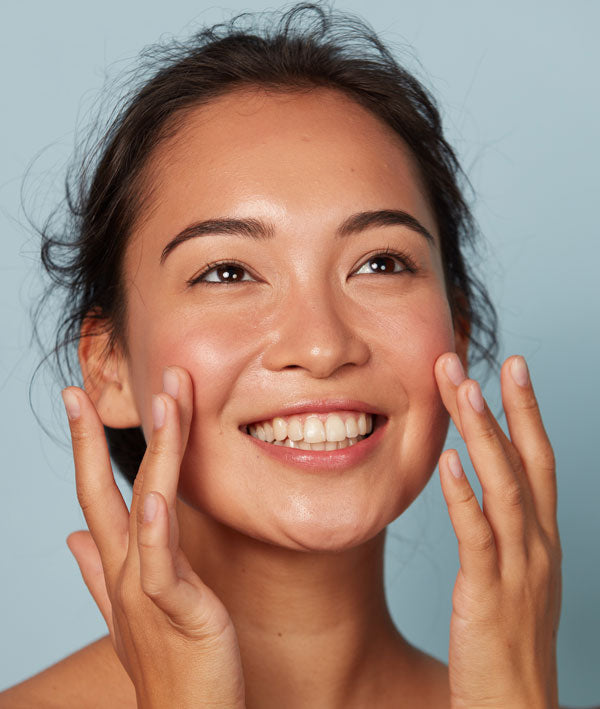Retinol is a highly effective skincare ingredient that can transform your complexion. However, if you want to get the best possible results, you need to know how to use it correctly.
Working retinol into your skincare regime requires knowing the ins and outs of what ingredients you can and cannot layer it with, as well as the order in which it should be layered with other products. Since this information can be understandably overwhelming, we’ve created an easy cheat sheet to guide you in the right direction. Here’s our comprehensive guide into everything you need to know about layering retinol with the serums you’re already using in your skincare routine.
Overview of Retinol
Retinol is a vitamin A derivative that offers a wide range of benefits, making it one of the most sought-after skincare ingredients. It can be found in many different formulations, but is most commonly sold as a cream or gel.
When applied topically, retinol boosts the production of elastin and collagen. This helps soften the appearance of fine lines and wrinkles while improving elasticity and firmness for a more youthful complexion.
Retinol also increases skin cell turnover rate. This makes it a particularly beneficial ingredient for those prone to breakouts, as it can help unclog pores to prevent acne. The process is also great for fading hyperpigmentation and dark spots for a more even skin tone.
Note that retinol – which falls under the umbrella of retinoids – typically refers to over-the-counter formulations. When you hear the term retinoid, on the other hand, know that it generally refers to solutions available by prescription. Both work in the same way, but retinol has a lower strength of retinoic acid than prescription retinoids. This means it can take longer to see results with retinol. A major upside, however, is that over-the-counter retinol products often come with a lower risk of negative side effects.
Understanding Your Skin Type
When it comes to working retinol into your routine, you need to consider your skin type, as each will have a different tolerance for the treatment. For example, someone with dry skin needs to manage the drying effects of retinol. If you have drier skin, it’s smart to pair your retinol with a hydrating serum and a rich cream. You’ll also want to make sure you don’t apply the treatment too frequently, as doing so can increase your risk of drying out the skin.
On the other hand, there are those with oily and combination skin. These skin types may have a better time tolerating retinol, but it’s still a good idea to pair it with a hydrating and/or calming serum to fight the side effects.
There’s also sensitive skin. Sensitive skin types need to take a very conservative approach when working retinol into their routine, since it can be so aggravating.
The Best Time to Use Retinol
If you’re considering adding retinol to your routine, you should only be applying it in the evening. This is because retinol (and retinoids in general) makes your skin more sensitive to UV light. Direct sun exposure may also degrade the ingredient, decreasing its efficacy.
When first starting out, it’s recommended that you begin by just applying it a couple times a week. This allows your skin to more easily adjust to the ingredient, which is known to cause irritation and dryness. After a few weeks, you can consider increasing the frequency if it seems suitable for your skin.
What Serums Does Retinol Work Well With?
Since retinol comes with a risk of causing irritation and dryness, it’s smart to layer it with serums that are gentler on the skin. Hydrating and calming serums can help counteract the potential aggravation retinol may cause, meaning you’ll reap the benefits of retinol without having to suffer through the negative side effects.
If you’re looking to boost hydration, layer your retinol product of choice with a hyaluronic acid serum, which will lock moisture into the skin. On the other hand, if you want to give your skin an antioxidant boost, you can use a CoQ10 serum alongside retinol. Niacinamide serums – which can control sebum production, promote a more even skin tone, and reduce redness – also work well with retinol.
What Serums Should You Not Layer Retinol With?
There are also other ingredients that complement the effects of retinol but shouldnotbe layered at the same time.
Some prime examples are alpha hydroxy acids (such as glycolic and lactic acids) and beta hydroxy acids (such as salicylic acid). These chemical exfoliants are excellent for improving texture and tone, minimizing blemishes, and diminishing signs of aging. However, they can irritate the skin, and layering them with retinol will only increase your risk of aggravation (and can cause some serious damage to the skin barrier).
Don’t worry – this doesn’t mean you have to choose between the two! Consider alternating your usage by applying retinol one night, and then your exfoliating serum the next night.
Retinol also shouldn’t be layered with a vitamin C serum. Vitamin C is a multi-tasking ingredient that boosts radiance, provides anti-aging benefits, and protects the skin against damaging free radicals, thanks to its antioxidant powers. However, it can aggravate the skin, which makes it a more dangerous ingredient to apply alongside retinol. There’s also a big difference in pH levels between vitamin C and retinol, which means they can both make the other less effective when applied together.
That all said, using these two products in the same routine is easy. Simply apply a vitamin C serum in the morning, and then your retinol in the evening.
Incorporating Retinol into Your Skincare Routine
Retinol, a derivative of vitamin A, is renowned for its ability to boost collagen production, reduce fine lines, and promote cell turnover. However, its potency necessitates careful integration into your routine to prevent adverse reactions.
Step-by-Step Guide to Layering Retinol
-
Cleanse Your Skin: Start with a gentle cleanser suitable for your skin type to remove impurities.
-
Apply Retinol: On completely dry skin, apply a pea-sized amount of retinol. This prevents increased potency that can lead to irritation.
-
Wait Before Proceeding: Allow the retinol to absorb fully into the skin. This waiting period ensures maximum efficacy.
-
Apply Hyaluronic Acid Serum: After retinol has been absorbed, apply a hyaluronic acid serum to hydrate and plump the skin. Hyaluronic acid helps to alleviate potential dryness caused by retinol.
-
Moisturize: Finish with a moisturizer to seal in hydration and further reduce the risk of irritation.
Alternative Method: The Retinol Sandwich
For those with sensitive skin, the "retinol sandwich" technique can buffer the potency of retinol:
-
First Layer: Apply a hydrating serum, such as one containing hyaluronic acid, to clean, dry skin.
-
Second Layer: Apply retinol after the serum has absorbed.
-
Third Layer: Follow with another layer of the hydrating serum or a moisturizer to sandwich the retinol between hydrating products
How to Layer Retinol & Other Serums
Proper layering is key to seeing the best results with retinol and the other serums you use in your routine. As a general rule of thumb, you can follow the thinnest to thickest rule. This means first applying thinner formulations, and then following up with richer solutions.
If you’re layering a hyaluronic acid serum and a retinol serum, you can first apply your retinol to clean, dry skin. Let it absorb for at least 10 minutes, and then follow up with your hyaluronic acid serum, and then a moisturizer. That said, if you have dry or sensitive skin, you can choose to first apply the hyaluronic acid, and then the retinol. This creates a protective layer that further minimizes the risk of aggravating the skin.
Similar rules can be followed when using a CoQ10 face serum and retinol. You can apply a CoQ10 serum after the retinol has absorbed for 10 minutes, and then apply a moisturizer. Our CoQ10 Boost Serum contains hydrating ingredients like sodium hyaluronate and glycerin, so it’s also suitable to apply it before retinol if you want to further minimize the irritating effects.
Choosing the Right Retinol Product
Choosing the right retinol product for your needs comes down to your skin type and preferences. If you choose to go the prescription route, your dermatologist will help determine which treatment will work best for your specific needs.
For those looking for over-the-counter formulas, the key is finding a product with a concentration that will work for your skin type. If you are trying retinol for the first time, it’s best to stick with a lower concentration. You can work up to more potent concentrations over time, if desired. It’s typically best to stick with formulas with a 0.01% to 0.3% concentration of retinol. If you have dry or sensitive skin, look for options on the lower end of that spectrum.
You can also consider products beyond typical retinol treatments. For example, those with dry or sensitive skin looking for a gentler approach might want to reach for a night cream infused with retinol, as these are generally less aggressive than retinol treatments.
Importance of Frequency & Gradual Introduction
It’s crucial to note how important it is to gradually work retinol into your routine. While many want to jump right in to get the full benefits of retinol, overuse can wreak havoc on the skin. Your skin needs some time to adjust to the treatment, which means you should start by applying it one to two times per week for the first few weeks. If you apply it more frequently at the beginning, you run the risk of harming the skin barrier and causing dryness, peeling, and irritation.
After a few weeks – so long as your skin is reacting well to the treatment – you may choose to slowly increase your frequency of application. However, it’s important to find an application schedule that works for you. While some may be able to work towards using retinol nightly, others may find that they can only tolerate using it every other night (or less!). Don’t push it if it's not working for your skin – you want to find the balance where you reap the benefits without causing any aggravation.
Combining Retinol with Other Active Ingredients
While retinol is a powerful ingredient, combining it with certain other actives requires caution:
-
Vitamin C: It's generally recommended to use vitamin C in the morning and retinol at night to prevent potential irritation.
-
Acids (AHAs/BHAs): Using alpha or beta hydroxy acids with retinol can increase the risk of irritation. It's advisable to use them on alternate nights or consult with a dermatologist.
Monitoring Skin's Response
Pay close attention to how your skin responds to retinol. Mild redness or peeling can be normal during the initial stages. However, if severe irritation occurs, reduce the frequency of use or consult a skincare professional.
By understanding how to layer retinol with other products, you can harness its full potential while maintaining healthy, balanced skin.
Common Mistakes to Avoid
Here are a few common mistakes you should avoid when using retinol in your routine:
Applying Too Much: There’s no need to slather on the retinol. In fact, doing so can increase your risk of negative side effects. All you need is a pea-sized amount for your face and neck. Skipping Moisturizer: A good moisturizer will help restore moisture levels to counteract the drying effects of the treatment. For the best results, pair your retinol with a moisturizer that is made for your skin type. Applying to Damp Skin: When the skin is damp, the water can increase the absorption of topical products. This is a no-go for retinol, as it may lead to a higher risk of negative side effects.
There is one caveat to keep in mind. If you’ve chosen a moisturizer that contains retinol (rather than a thinner serum), that will be applied after your serums.







